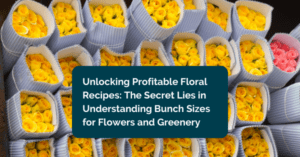Hellebores are among the first flowers to grow in the garden in the snow; however, cutting and processing them to boost longevity can be challenging. Despite this, hellebores and blooms have subtle hues and grace gardens with various colors. Mastering active processing techniques is essential to prolong their beauty in indoor arrangements. Each stage of a hellebore’s growth demands specific attention to ensure enduring vase life. Here’s how to process hellebores right from your garden.
1. Understanding Growth Stages to Process Hellebores:
Hellebores progress through distinct stages of growth, each demanding unique care:
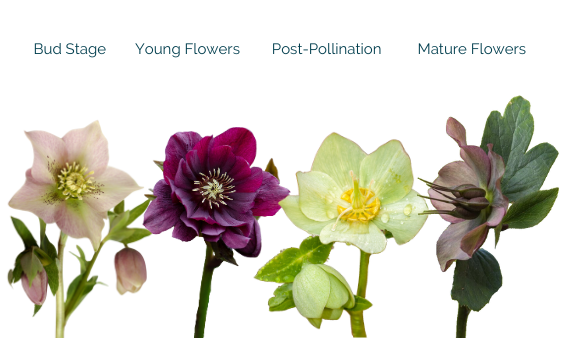
- Bud Stage: At this stage, hellebores are preparing to bloom. Consequently, keeping the buds hydrated and protected from harsh weather conditions is crucial. Moreover, mulching around the plants can help retain moisture and regulate soil temperature, ensuring optimal conditions for bud development.
- Young Flowers: As the blooms emerge, they are most delicate. Therefore, removing lower leaves is imperative to prevent water loss and bacterial buildup, maximizing their longevity. Additionally, scoring the stems with a clean, sharp knife enhances water absorption, while submerging them in cool water for 24 hours ensures thorough hydration.
- Post-Pollination: After the stamens drop, indicating fertilization, the stems gain robustness, rendering them suitable for cutting. Consequently, trim the stems at an angle and briefly sear them in boiling water to remove air bubbles and ensure proper water uptake. Subsequently, plunging the stems into cool water reinforces their structure before arranging them.
- Mature Flowers: Fully developed blooms with visible seed pods boast maximum durability. To extend their vase life, cut the stems at an angle and place them in tepid water for extended hydration. Moreover, changing the water regularly and displaying the arrangements away from direct sunlight and drafts can further prolong the bloom’s life.
- In conclusion, mastering these distinct stages of hellebore processing ensures optimal longevity and beauty in floral arrangements.
Three Conditioning Methods: In Detail for Florist to Process Hellebores
No matter which method works for processing the cut hellebores, be assured that on True Client Pro, Floral Library, you can add the How to process the flowers instructions that fit you and your business and have it automatically pull this information on the prep list. In addition to that, we have 11 different varieties listed in the floral product library, so as you start creating beautiful floral arrangements, you can create floral arrangement recipes, save them in the floral library, and use them, again and again, to make sure you are profitable in your floral business.
Scoring (for Young Flowers):
For young hellebore flowers, characterized by delicate blooms with intact stamens, scoring is a vital conditioning technique to enhance water absorption and longevity. Here’s a detailed breakdown of the process:
- Preparation: Begin by preparing the hellebore stems for scoring. Remove any lower leaves to prevent water loss and bacterial buildup. This ensures that water is directed towards the blooms, maximizing hydration.
- Scoring Technique: Using a small, clean, and sharp knife, carefully score the stem. Make a fine 1-2mm deep slit along the side of the entire stem, starting from the base and extending just below the flower head. This incision significantly increases the surface area available for water uptake.
- Hydration Phase: After scoring, immediately submerge the stems in cool water. Ensure that the water level is sufficient to cover the entire length of the slit. The hellebore blooms remain hydrated and resilient by providing ample hydration, extending their vase life.
- Utilization in Arrangements: Once the stems have been scored and hydrated for 24 hours, they can be incorporated into floral arrangements. The increased water absorption facilitated by scoring ensures that the hellebore blooms maintain their freshness and vibrancy for an extended period.
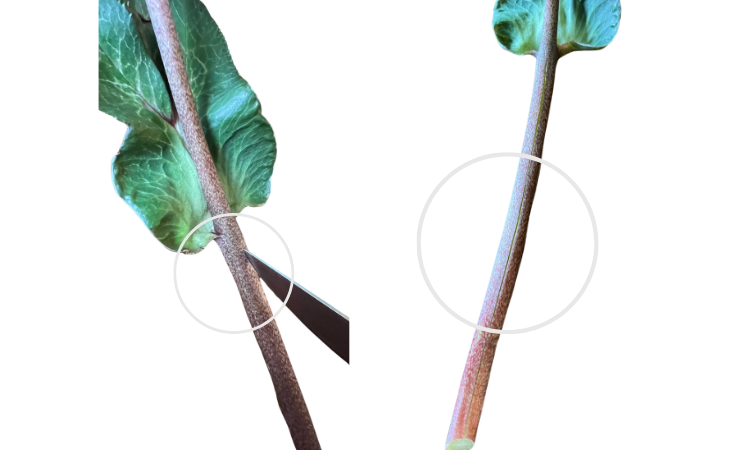
Searing (Once Stamens Have Dropped):
Searing is a rapid conditioning technique suitable for hellebore flowers after stamens have dropped, indicating fertilization. Consequently, this process removes air bubbles and enhances water uptake, resulting in robust and long-lasting stems. Here’s a step-by-step guide to searing hellebore stems:
- Preparation: Similar to scoring, begin by stripping lower leaves from the hellebore stems. This minimizes water loss and bacterial contamination, preparing the stems for conditioning. Additionally,
- Searing Process: First, cut the ends of the hellebore stems at an angle using sharp scissors or pruning shears. Next, immediately immerse the cut ends in just-boiled water for approximately 15-20 seconds. This rapid searing causes the stem to blacken, indicating the process is complete. Moreover,
- Hydration Phase: After searing, transfer the stems to cool water and allow them to rest for a few hours. This phase facilitates water uptake and helps the stems regain rigidity and strength, ensuring they remain upright and vibrant in floral arrangements. Additionally,
- Arrangement Preparation: Once adequately hydrated, the seared hellebore stems are ready to be arranged in floral displays. Their enhanced water absorption capacity ensures they remain fresh and resilient, adding elegance to any arrangement.
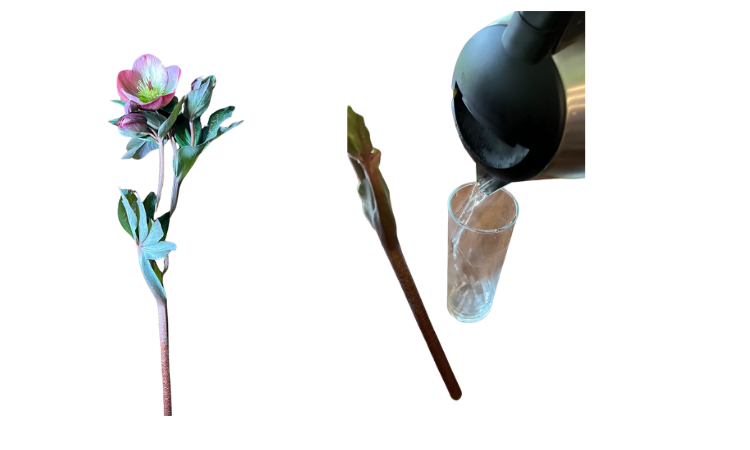
Classic Conditioning (for Mature Hellebores Flowers):
Classic conditioning is a straightforward yet effective technique suitable for mature hellebore flowers. Moreover, these flowers exhibit maximum durability with fully developed blooms and visible seed pods. Here’s how to condition mature hellebore stems:
- Preparation: Similar to the previous techniques, begin by stripping lower leaves from the hellebore stems. This ensures that the focus remains on water absorption and hydration, prolonging the flowers’ vase life.
- Cutting Technique: Using sharp, clean scissors or pruning shears, make a clean cut at a 1cm angle from the base of the stem. This angled cut increases the surface area for water absorption, allowing the stems to draw in ample hydration.
- Container Preparation: Ensure the containers or vases holding the hellebore stems are meticulously clean. Cleanliness is crucial for preventing bacterial growth and maintaining the flowers’ freshness.
- Resting Period: Allow the stems to rest in tepid water for a few hours or overnight in a cool, dark place. This resting period allows the hellebore stems to absorb water fully, ensuring they remain sturdy and resilient in arrangements.
Utilizing these three conditioning methods, tailored to the distinct growth stages of hellebore flowers, enables you to extend their longevity and elevate their allure in floral compositions. Whether scoring young flowers, searing post-stamen drops, or applying classic conditioning to mature blooms, each technique assumes a pivotal role in safeguarding the freshness and vibrancy of hellebores.
Embarking on the journey of processing hellebores for prolonged vase life offers a gratifying opportunity to showcase their indoor splendor. By comprehending their growth phases and implementing suitable techniques, you can metamorphose your garden’s blooms into captivating arrangements that mesmerize observers for an extended period. With meticulous care and attention to detail, you unlock the complete potential of hellebores, enriching both your home and garden aesthetics.
Hellebores Flowers Anatomy: The Stamens & Seedpod
Understanding the anatomy of hellebores flowers, particularly the stamens and seedpod, is crucial for effective processing and care. Here’s a closer look at these essential components:
Hellebores Flowers Anatomy: Stamens:
The stamens are reproductive organs found within the hellebores flower. They consist of a filament, a slender stalk-like structure topped by an anther. The anther contains pollen sacs, where pollen grains are produced. During the flowering process, the stamens play a vital role in pollination, transferring pollen from the anther to the stigma of the same flower or another.
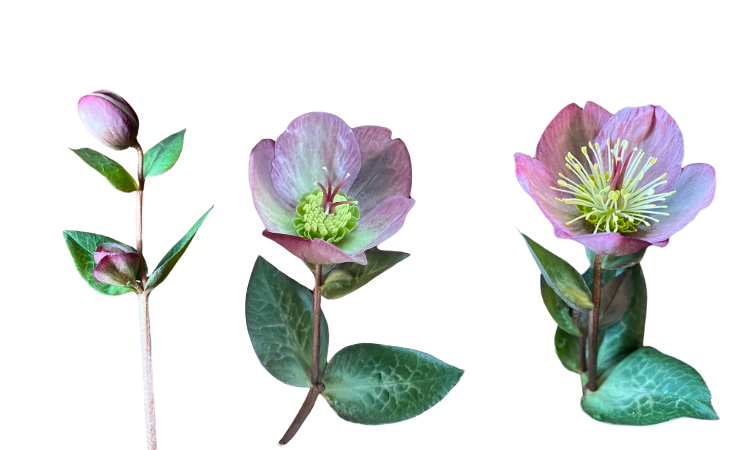
Identifying the presence or absence of stamens is key in determining the growth stage of hellebore flowers. The flower is considered young and delicate when stamens are present and intact. Processing techniques such as scoring are recommended during this stage to maximize water absorption and prolong vase life. Once the stamens drop, indicating fertilization, the flower transitions to a more mature stage, suitable for different conditioning methods.
Hellebores Flowers Anatomy: Seedpod:
The seedpod, also known as the carpel or pistil, is the female reproductive organ of the hellebore flower. After successful pollination, the fertilized ovule within the ovary develops into a seedpod. The seedpod contains seeds, which are dispersed to propagate new hellebore plants.
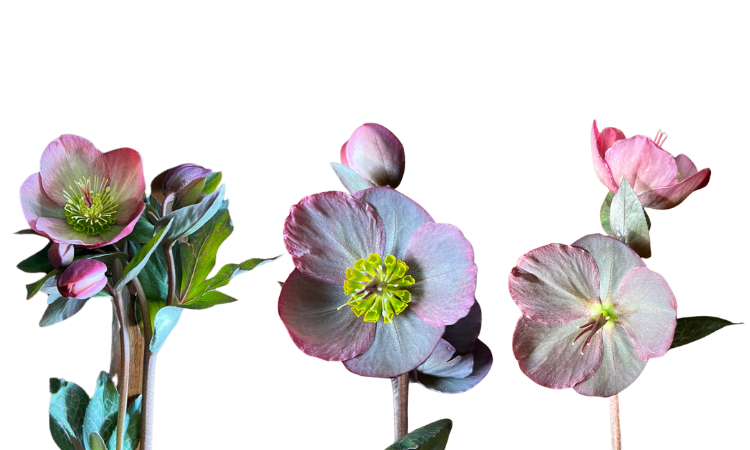
In mature hellebore flowers, the seedpod becomes visibly developed, typically located at the center of the flower. A well-formed seedpod indicates that pollination has occurred and that the flower is in the later stages of its lifecycle. Flowers with developed seedpods tend to be sturdier and more resilient, making them suitable for classic conditioning techniques to prolong vase life.
Understanding the significance of the stamens and seedpod in hellebores flowers allows growers and florists to make informed decisions regarding processing and care. Additionally, recognizing the growth stages associated with these floral components allows individuals to implement appropriate conditioning methods to maximize hellebore arrangements’ longevity and aesthetic appeal.
Hellebores can be obtained through three primary avenues:
Each source offers distinct benefits and valuable insights into the world of hellebores, regardless of where you source them.
1. Get Your Hellebores From Nursery Growers:
Nursery growers specialize in cultivating hellebores as plants, offering them in various stages of growth. Additionally, these plants can be purchased and nurtured in home gardens, providing a continuous supply of blooms for indoor arrangements. Furthermore, nursery growers often provide valuable advice on caring for hellebores as plants, ensuring optimal growth and flowering.
Benefits:
- Access to a wide variety of hellebore species and cultivars.
- Ability to observe the growth and development of hellebores from an early stage.
- Personalized guidance on planting, watering, and maintenance practices tailored to specific hellebore varieties.
Suggestion:
- Opt for plants in full bloom to gauge the height and orientation of flower stems.
- Choose plants with downward-facing blooms, offering protection from the elements and enhancing pollination.
- Consider waiting to cut flowers until after stamens have dropped for extended vase life.
2. Work With Flower Wholesalers Who Specialises In Hellebores:
Collaborating with wholesalers is crucial for florists looking to enhance their offerings. Moreover, partnering with wholesalers who prioritize quality and expertise in flower selection ensures access to premium hellebores that are ideal for arrangements.
Flower wholesalers play a pivotal role in the floral industry. They function as intermediaries between hellebore growers and florists, offering a diverse selection of cut flowers for commercial use and maintaining close relationships with hellebore growers, guaranteeing access to premium-quality blooms. Additionally, flower wholesalers provide valuable insights into the seasonal availability and optimal handling of hellebores for floral arrangements.
Benefits:
- Convenient access to freshly cut hellebores sourced directly from growers.
- Assurance of quality and consistency in hellebore selection, ideal for professional floristry.
- Expert advice on conditioning techniques and storage practices to maximize vase life.
Suggestion:
- Rely on the expertise of growers to select the best-quality hellebores for arrangements.
- Follow recommended conditioning methods, such as searing or classic conditioning, to enhance longevity.
- Prioritize flowers with visibly dropped stamens and develop seedpods for optimal durability.
3. Connect With Your Local Flower Farmers and Florist Friends:
Flower farmers cultivate hellebores independently, offering locally grown blooms to consumers and florists. Additionally, they possess firsthand knowledge of hellebore cultivation and are passionate about promoting sustainable floral practices. Moreover, flower farmers provide valuable insights into the seasonal availability, handling, and care of hellebores, ensuring their freshness and beauty.
Consulting experienced flower farmer florists is essential when seeking advice on conditioning techniques. Their expertise can significantly refine your processing methods, creating stunning, long-lasting hellebore arrangements that captivate lifelong flower friends.
Benefits:
- Support local agriculture and sustainable flower farming practices.
- Access to freshly harvested hellebores with minimal transportation and environmental impact.
- Direct communication with farmers for personalized advice on hellebore varieties and care techniques.
Suggestion:
- Embrace the seasonal availability of hellebores, appreciating their unique beauty in different growing conditions.
- Prioritize purchasing locally grown hellebores to support community farmers and reduce carbon footprint.
- Engage with flower farmers to learn about hellebore cultivation methods and sustainable floral practices.
Whether obtained from nursery growers, flower wholesalers, or flower farmers, hellebores offer a wealth of beauty and versatility for floral enthusiasts. Moreover, each source provides valuable expertise and guidance on selecting, handling, and caring for hellebores, ensuring their enduring charm in home gardens and floral arrangements.
Actively processing hellebores for extended vase life is a rewarding endeavor that allows their beauty to flourish indoors. By adapting techniques to their growth stages and embracing expert insights, you transform garden blooms into stunning arrangements that captivate admirers. Consequently, with care and attention to detail, unlock the full potential of hellebores, enriching your home and garden with their timeless elegance.




